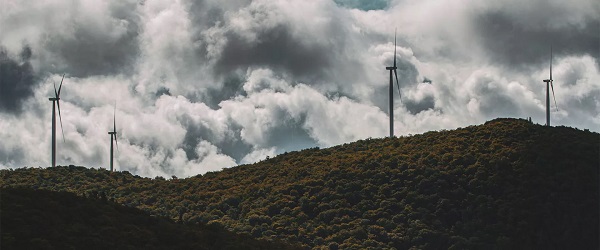Energy
Next federal government should close widening gap between Canadian and U.S. energy policy

From the Fraser Institute
After accounting for backup, energy storage and associated indirect costs—estimated solar power costs skyrocket from US$36 per megawatt hour (MWh) to as high as US$1,548, and wind generation costs increase from US$40 to up to US$504 per MWh.
At a recent energy conference in Houston, U.S. Energy Secretary Chris Wright said the Trump administration will end the Biden administration’s “irrational, quasi-religious policies on climate change that imposed endless sacrifices on our citizens.” He added that “Natural gas is responsible for 43 per cent of U.S. electricity production,” and beyond the obvious scale and cost problems, there’s “simply no physical way that wind, solar and batteries could replace the myriad uses of natural gas.”
In other words, as a federal election looms, once again the United States is diverging from Canada when it comes to energy policy.
Indeed, wind power is particularly unattractive to Wright because of its “incredibly high prices,” “incredibly huge investment” and “large footprint on the local communities,” which make it unattractive to people living nearby. Globally, Wright observes, “Natural gas currently supplies 25 per cent of raw energy globally, before it is converted into electricity or some other use. Wind and solar only supply about 3 per cent.”
And he’s right. Renewables are likely unable, physically or economically, to replace natural gas power production to meet current or future needs for affordable, abundant and reliable energy.
In a recent study published by the Fraser Institute, for example, we observed that meeting Canada’s predicted electricity demand through 2050 using only wind power (with natural gas discouraged under current Canadian climate policies) would require the construction of approximately 575 wind-power installations, each the size of Quebec’s Seigneurie de Beaupré wind farm, over 25 years. However, with a construction timeline of two years per project, this would equate to 1,150 construction years. This would also require more than one million hectares of land—an area nearly 14.5 times the size of Calgary.
Solar power did not fare much better. According to the study, to meet Canada’s predicted electricity demand through 2050 with solar-power generation would require the construction of 840 solar-power generation stations the size of Alberta’s Travers Solar Project. At a two-year construction time per facility, this adds up to 1,680 construction years to accomplish.
And at what cost? While proponents often claim that wind and solar sources are cheaper than fossil fuels, they ignore the costs of maintaining backup power to counter the unreliability of wind and solar power generation. A recent study published in Energy, a peer-reviewed energy and engineering journal, found that—after accounting for backup, energy storage and associated indirect costs—estimated solar power costs skyrocket from US$36 per megawatt hour (MWh) to as high as US$1,548, and wind generation costs increase from US$40 to up to US$504 per MWh.
The outlook for Canada’s switch to renewables is also dire. TD Bank estimated that replacing existing gas generators with renewables (such as solar and wind) in Ontario could increase average electricity costs by 20 per cent by 2035 (compared to 2021 costs). In Alberta, electricity prices would increase by up to 66 per cent by 2035 compared to a scenario without changes.
Under Canada’s current greenhouse gas (GHG) regulatory regime, natural gas is heavily disfavoured as a potential fuel for electricity production. The Trudeau government’s Clean Electricity Regulations (CER) would begin curtailing the use of natural gas beginning in 2035, leading largely to a cessation of natural gas power generation by 2050. Under CER and Ottawa’s “net-zero 2050” GHG emission framework, Canada will be wedded to a quixotic mission to displace affordable reliable natural gas power-generation with expensive unreliable renewables that are likely unable to meet expected future electricity demand.
With a federal election looming, Canada’s policymakers should pay attention to new U.S. energy policy on natural gas, and pull back from our headlong rush into renewable power. To avoid calamity, the next federal government should scrap the Trudeau-era CER and reconsider the entire “net-zero 2050” agenda.
Energy
Activists using the courts in attempt to hijack energy policy

2016 image provided by Misti Leon, left, sits with her mom, Juliana Leon. Misti Leon is suing several oil and gas companies in one of the first wrongful-death claims in the U.S. seeking to hold the fossil fuel industry accountable for its role in the changing climate.

From the Daily Caller News Foundation
By Jason Isaac
They twist yesterday’s weather into tomorrow’s crisis, peddle apocalyptic forecasts that fizzle, and swap “global warming” for “climate change” whenever the narrative demands. They sound the alarm on a so-called climate emergency — again and again.
Now, the Left has plunged to a new low: weaponizing the courts with a lawsuit in Washington State that marks a brazen, desperate escalation. This isn’t just legal maneuvering—it’s the exploitation of personal tragedy in service of an unpopular anti-energy climate crusade.
Consider the case at the center of a new legal circus: Juliana Leon, 65, tragically died of hyperthermia during a 100-mile drive in a car with broken air conditioning, as a brutal heat wave pushed temperatures to 108 degrees Fahrenheit.
Dear Readers:
As a nonprofit, we are dependent on the generosity of our readers.
Please consider making a small donation of any amount here.
Thank you!
The lawsuit leaps from this heartbreaking event to a sweeping claim: that a single hot day is the direct result of global warming.
The lawsuit preposterously links a very specific hot weather event to theorized global warming. Buckle up—their logic is about to take a wild ride.
Some activist scientists have further speculated that what may be a gradual long-term trend of slight warming thought to be both cyclical and natural, might be possibly exacerbated by the release of greenhouse gases. Some of these releases are the result of volcanic activity while some comes from human activities, including the burning of oil, natural gas and coal.
Grabbing onto that last, unproven thread, the plaintiffs have zeroed in on a handful of energy giants—BP, Chevron, Conoco, Exxon, Phillips 66, Shell, and the Olympic Pipe Company—accusing them of causing Leon’s death. Apparently, these few companies are to blame for the entire planet’s climate, while other oil giants, coal companies, and the billions of consumers who actually use these fuels get a free pass.
Meanwhile, “climate journalists” in the legacy media have ignored key details that will surely surface in court. Leon made her journey in a car with no air conditioning, despite forecasts warning of dangerous heat. She was returning from a doctor’s visit, having just been cleared to eat solid food after recent bariatric surgery.
But let’s be clear: this lawsuit isn’t about truth, justice, or even common sense. It’s lawfare, plain and simple.
Environmental extremists are using the courts to hijack national energy policy, aiming to force through a radical agenda they could never pass in Congress. A courtroom win would mean higher energy prices for everyone, the potential bankruptcy of energy companies, or their takeover by the so-called green industrial complex. For the trial lawyers, these cases are gold mines, with contingency fees that could reach hundreds of millions.
This particular lawsuit was reportedly pitched to Leon’s daughter by the left-leaning Center for Climate Integrity, a group bankrolled by billionaire British national Christopher Hohn through his Children’s Investment Fund Foundation and by the Rockefeller Foundation. It’s yet another meritless claim in the endless list of climate lawsuits that are increasingly being tossed out of courts across the country.
Earlier this year, a Pennsylvania judge threw out a climate nuisance suit against oil producers brought by Bucks County, citing lack of jurisdiction. In New York, Supreme Court Justice Anar Patel dismissed a massive climate lawsuit by New York City, pointing out the city couldn’t claim both public awareness and deception by oil companies in the same breath.
But the Washington State case goes even further, threatening to set a dangerous precedent: if it moves forward, energy companies could face limitless liability for any weather-related injury. Worse, it would give unwarranted credibility to the idea — floated by a leftwing activist before the U.S. Senate — that energy executives could be prosecuted for homicide, a notion that Republican Texas Sen. Ted Cruz rightly called “moonbeam, wacky theory.”
The courts must keep rejecting these absurd lawfare stunts. More importantly, America’s energy policy should be set by Congress—elected and accountable—not by a single judge in a municipal courtroom.
Jason Isaac is the founder and CEO of the American Energy Institute. He previously served four terms in the Texas House of Representatives.
Alberta
Temporary Alberta grid limit unlikely to dampen data centre investment, analyst says
From the Canadian Energy Centre
By Cody Ciona
‘Alberta has never seen this level and volume of load connection requests’
Billions of investment in new data centres is still expected in Alberta despite the province’s electric system operator placing a temporary limit on new large-load grid connections, said Carson Kearl, lead data centre analyst for Enverus Intelligence Research.
Kearl cited NVIDIA CEO Jensen Huang’s estimate from earlier this year that building a one-gigawatt data centre costs between US$60 billion and US$80 billion.
That implies the Alberta Electric System Operator (AESO)’s 1.2 gigawatt temporary limit would still allow for up to C$130 billion of investment.
“It’s got the potential to be extremely impactful to the Alberta power sector and economy,” Kearl said.
Importantly, data centre operators can potentially get around the temporary limit by ‘bringing their own power’ rather than drawing electricity from the existing grid.
In Alberta’s deregulated electricity market – the only one in Canada – large energy consumers like data centres can build the power supply they need by entering project agreements directly with electricity producers.
According to the AESO, there are 30 proposed data centre projects across the province.
The total requested power load for these projects is more than 16 gigawatts, roughly four gigawatts more than Alberta’s demand record in January 2024 during a severe cold snap.
For comparison, Edmonton’s load is around 1.4 gigawatts, the AESO said.
“Alberta has never seen this level and volume of load connection requests,” CEO Aaron Engen said in a statement.
“Because connecting all large loads seeking access would impair grid reliability, we established a limit that preserves system integrity while enabling timely data centre development in Alberta.”
As data centre projects come to the province, so do jobs and other economic benefits.
“You have all of the construction staff associated; electricians, engineers, plumbers, and HVAC people for all the cooling tech that are continuously working on a multi-year time horizon. In the construction phase there’s a lot of spend, and that is just generally good for the ecosystem,” said Kearl.
Investment in local power infrastructure also has long-term job implications for maintenance and upgrades, he said.
“Alberta is a really exciting place when it comes to building data centers,” said Beacon AI CEO Josh Schertzer on a recent ARC Energy Ideas podcast.
“It has really great access to natural gas, it does have some excess grid capacity that can be used in the short term, it’s got a great workforce, and it’s very business-friendly.”
The unaltered reproduction of this content is free of charge with attribution to the Canadian Energy Centre.
-

 Addictions1 day ago
Addictions1 day agoWhy B.C.’s new witnessed dosing guidelines are built to fail
-

 Frontier Centre for Public Policy2 days ago
Frontier Centre for Public Policy2 days agoCanada’s New Border Bill Spies On You, Not The Bad Guys
-

 Business1 day ago
Business1 day agoCarney Liberals quietly award Pfizer, Moderna nearly $400 million for new COVID shot contracts
-

 Business1 day ago
Business1 day agoMark Carney’s Fiscal Fantasy Will Bankrupt Canada
-

 Energy2 days ago
Energy2 days agoCNN’s Shock Climate Polling Data Reinforces Trump’s Energy Agenda
-

 Opinion1 day ago
Opinion1 day agoCharity Campaigns vs. Charity Donations
-

 Red Deer1 day ago
Red Deer1 day agoWesterner Days Attraction pass and New Experiences!
-

 COVID-191 day ago
COVID-191 day agoTrump DOJ dismisses charges against doctor who issued fake COVID passports






